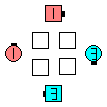From 8-dancer formations consisting of 4 inside dancers and 4 outside dancers.
The inside 4 dancers do the given call working within the Center of the set as
the outside 4 dancers do the given call working with each other,
around the outside of the set.
Notes:
-
A good way to think about Concentric is to imagine dropping a
stone in a pool of still water and watching the concentric rings
rippling outward from the center where the stone dropped. If you
overlay that image in your mind on top of the square, the Center 4
dancers would be working within the innermost ring, and the Outside
4 dancers would be working between the innermost ring and the next
outside ring. Each group of 4 works independently of the other group
of 4, maintaining their respective relationship from the other group
and the very center of the set.
-
The inside 4 dancers always do the call normally working in the Center.
-
The ending positions for the outside 4 dancers depends upon
the kind of formation (explained below).
| (A) |
If the given call ends in a 1x4, a Diamond, or a Single 1/4 Tag,
then there is only one possible ending formation: a 1x4 is split in half,
and distributed as two 1x2 formations on opposite sides of the inside
dancers; a Diamond or Single 1/4 Tag is split into 4
pieces, and distributed like the points of a Galaxy. |
|
The above formations show the ending positions for the
outside dancers when the given call ends in a 1x4 or
a Diamond. The dashed boxes represent the Center 4
dancers who could be in a 2x2 (as shown), a 1x4
(horizontal or vertical), or any other 4-dancer formation. |

| |

| before
Outsides Concentric Pass The Ocean | | after
|
|

| |

| before
Outsides Concentric Switch To A Diamond | | after
|
|
| (B) |
For the outside 4 dancers, if the given call starts
and ends in a 2x2 then the following rules apply:- If the outside 4 started as if they were Ends of Parallel Lines, then
they must finish so that they are Ends of Parallel Lines.
- Similarly, if the outside 4 started as if they were Ends of Columns,
then they must finish so that they are Ends of Columns.
The two rules above are known as the 'Lines-to-Lines, Columns-to-Columns' rule.
That is, if you start in Parallel Lines, you must end in Parallel Lines; if you start in
Columns, you must end in Columns. Note that the final formation
may not actually be Lines or Columns, since the Centers may end T-Boned to the Ends. |
|
Examples of formations in which the Outside 4 dancers "think" they are Ends of Lines:
|
|
Examples of formations in which the Outside 4 dancers "think" they are Ends of Columns:
|
Outsides Concentric Walk & Dodge:

| |

| before
Outsides
Concentric Walk & Dodge | | after
|
|

| |

| before
Outsides
Concentric Walk & Dodge | | after
|
|
Outsides Concentric Partner Tag:

| |

| before
Outsides
Concentric Partner Tag | | after
|
|

| |

| before
Outsides
Concentric Partner Tag | | after
|
|
| (C) |
For the outside 4 dancers, if the given call does
not start in a 2x2 but ends in a 2x2
then the following rule applies:- The Outside 4 must end in the positions so that the long axis of
the setup changes by 90°.
Many formations in square dancing have a long axis and a short axis. That
is, the formation is visibly longer in one direction (long axis) than
the other direction (short axis). When dancing the Concentric Concept,
if the outside 4 do not start in a 2x2, but end in a 2x2,
then they must end on the
footprints which change the original long axis of the formation by 90°.
|

| |

| before
Outsides
Concentric Recycle | | after
|
|

| |

| before
Outsides
Concentric Hinge | | after
|
|
|
Concentric Bend The Line:
| | RIGHT | | WRONG |

| |

| |

| before
Concentric Bend The Line | | after | | This ending formation is incorrect
since the long-axis did not change |
|
| | RIGHT | | WRONG |

| |

| |

| before
Concentric Turn & Deal | | after | | This ending formation is incorrect
since the long-axis did not change |
|
| | RIGHT | | WRONG |

| |

| |

| before
Concentric Linear Cycle | | after | | Ending here feels 'right' but
is incorrect since the
long-axis did not change |
|
Concentric Touch 1/4: (using the Lines-to-Lines, Columns-to-Columns rule)

| |

| before
Concentric Touch 1/4 | | after
|
|

| |

| before
Concentric Touch 1/4 | | after
|
|
Concentric Chase Right: (using the Lines-to-Lines, Columns-to-Columns rule)

| |

| before
Concentric Chase Right | | after
|
|

| |

| before
Concentric Chase Right | | after
|
|
More notes:
-
As soon as you hear the word 'Concentric', check to see if you are in
Lines or Columns. If you are not in either Lines or Columns, check the
orientation of your long axis.
Single Concentric Concept [C4]:
From a 1 x 4 or other applicable 4-dancer
formations. Centers work with each other to do the given call as Ends work
around the Centers to do the given call.

| |

| before
Single Concentric
Single Wheel | | after
|
|
See also Cross Concentric Concept [C2].